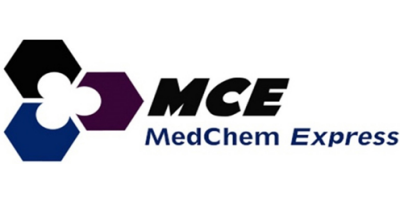

MedChemExpress - Model TES-1025 - 1883602-21-8
TES-1025 is a potent and selective human α-amino-β-carboxymuconate-ε-semialdehyde decarboxylase (ACMSD) inhibitor with an IC50 of 13 nM[1].MCE products for research use only. We do not sell to patients.
TES-1025
MCE China:TES-1025
Brand:MedChemExpress (MCE)
Cat. No.HY-111365
CAS:1883602-21-8
Purity:98.12%
Storage:Powder -20°C 3 years 4°C 2 years In solvent -80°C 2 years -20°C 1 year
Shipping:Room temperature in continental US; may vary elsewhere.
Description:TES-1025 is a potent and selective human α-amino-β-carboxymuconate-ε-semialdehyde decarboxylase (ACMSD) inhibitor with an IC50 of 13 nM.
In Vitro:TES-1025 is a low nanomolar human ACMSD inhibitor, which increases NAD+ levels in cellular systems[1].
In Vivo:TES-1025 is subjected to in vivo pharmacokinetic studies, following intravenous (IV) and oral (PO) dosings of male CD-1 mice. After the intravenous administration of 0.5 mg/kg, TES-1025 shows low blood clearance, with low volumes of distribution and half-lives (t1/2) of about 5.33 h, although after oral administration at 5 mg/kg, the blood concentration of TES-1025 is quantifiable for up to 8 h. A good systemic exposure is recorded for TES-1025, with a Cmax of 2570 ng/mL reaches at 2 h after dosing. The greater oral exposure of TES-1025 is further confirmed in the liver and kidneys with AUC0-8h of 19?200 h?ng/mL and 36?600 h?ng/mL, respectively[1].
Animal Administration:Mice[1] Male CD-1 mice are used.The study is conducted in 3 phases. Phase 1: 18 mice receive an oral administration of TES-1025 at a target dose level of 5 mg/kg. Blood, brain and liver are collected at intervals up to 8 h after dose administration (n=3 animals per each time point). Phase 2: 3 mice receive each an intravenous administration of TES-1025 at a target dose of 0.5 mg/kg. Blood samples are collected from the lateral tail vein at intervals up to 24 h after dose administration. Phase 3: 3 mice receive a single intravenous administration of Elacridar (5 mg/kg) shortly before an oral administration of TES-1025 at a target dose of 5 mg/kg. Blood and brain samples are collected 0.5 h after dose administration. Brain, liver and kidney are collected from all animals of the study[1].
Kinase Assay:Recombinant hACMSD is expressed in Pichia pastoris and purified. Its enzyme activity is assayed by a coupled spectrophotometric assay. Briefly, in a pre-assay mixture, the ACMS substrate is generated from 10 μM 3-hydroxyanthranilic acid by recombinant 3-hydroxyanthranilate 3,4-dioxigenase from Ralstonia metallidurans. ACMS formation is monitored at 360 nm, and after the reaction is complete, an appropriate amount of ACMSD is added. Activity is calculated from the initial rate of the absorbance decrease subtracted from that of a control reaction mixture in the absence of ACMSD. The effects of the various compounds (e.g., TES-1025) on the enzyme activity are tested by adding the compounds to the assay mixture along with ACMSD. For the IC50 evaluations for each compound, a serial dilution from a stock solution prepared in DMSO is tested, maintaining a DMSO concentration in all the reaction mixtures of 1.0%. One unit is defined as the amount of enzyme that consume 1 μmol of ACMS per minute at 37°C[1].
IC50 & Target:IC50: 13±3 nM (human ACMSD)[1] In Vitro TES-1025 is a low nanomolar human ACMSD inhibitor, which increases NAD+ levels in cellular systems[1]. MedChemExpress (MCE) has not independently confirmed the accuracy of these methods. They are for reference only. 0 --> TES-1025 Related Antibodies
Hot selling product:4-Hydroxyatomoxetine | Tafasitamab | PSI | Dienogest | Curcumenol | Oxyphenbutazone | HB-EGF, Mouse | Lecirelin | Platelet Factor 4 (58-70), human | Kojic acid
Trending products:Recombinant Proteins | Bioactive Screening Libraries | Natural Products | Fluorescent Dye | PROTAC | Isotope-Labeled Compounds | Oligonucleotides
References:
[1]. Pellicciari R, et al. α-Amino-β-carboxymuconate-ε-semialdehyde Decarboxylase (ACMSD) Inhibitors as Novel Modulators of De Novo Nicotinamide Adenine Dinucleotide (NAD+) Biosynthesis. J Med Chem. 2018 Feb 8;61(3):745-759. [Content Brief]
Brand introduction:
• MCE (MedChemExpress) has a global exclusive compound library of more than 200 kinds, and we are committed to providing the most comprehensive range of high-quality small molecule active compounds for scientific research customers around the world;
• More than 50,000 highly selective inhibitors and agonists are involved in various popular signaling pathways and disease areas;
• The products cover a variety of recombinant proteins, peptides, commonly used kits, more PROTAC, ADC and other characteristic products, widely used in new drug research and development, life science and other scientific research projects;
• Provide virtual screening, ion channel screening, metabolomics analysis detection analysis, drug screening and other professional technical services;
• It has a professional experimental center and strict quality control and verification system;
• Provide LC/MS, NMR, HPLC, chiral analysis, elemental analysis and other quality inspection reports to ensure the high purity and high quality of products;
• The biological activity of the products has been verified by the experiments of customers in various countries;
• A variety of top journals such as Nature, Cell, Science and pharmaceutical patents have included the scientific research results of MCE customers;
• Our professional team tracks the latest pharmaceutical and life science research and provides you with the latest active compounds in the world;
• It has established long-term cooperation with the world's major pharmaceutical companies and well-known scientific research institutions。
